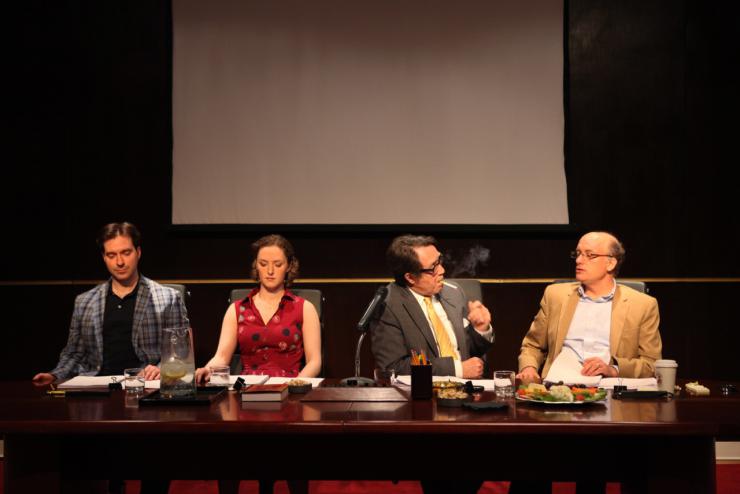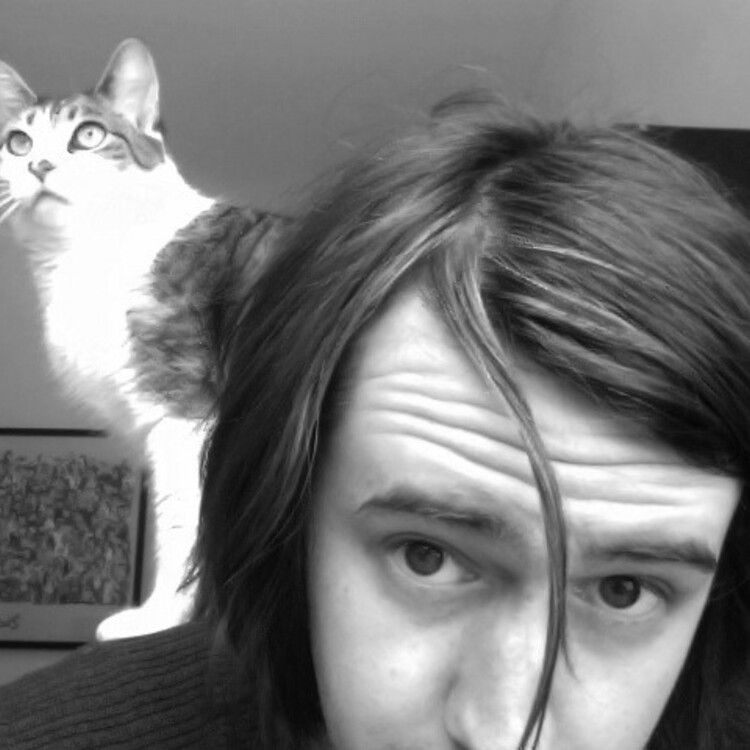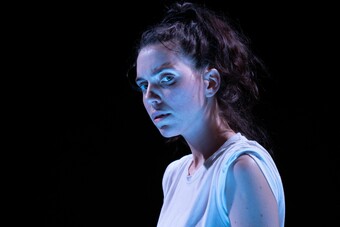A Public Reading Of an Unproduced Screenplay About the Death of Walt Disney
We shouldn't be surprised that Walt Disney has something up his sleeve. He is a showman, after all, and a showman always keeps something clever in reserve. So when Walt—moustachioed, imperial and cruel—takes a handkerchief out of his pocket, it's natural that it will turn into three, four, seven or eight more. They tumble out of his sleeve, falling to the floor, but somewhere the trick has gone wrong. The hankies are covered in blood. The showman is beginning to die.
Lucas Hnath's A Public Reading Of an Unproduced Screenplay About the Death of Walt Disney, which opened May 9 at Soho Rep and runs through June 9, is a poetic examination of a famous magician's attempt to execute the greatest trick of all: immortality. It's an audacious gambit, and it's clear from the first scene—and the presence of "Death" in the play's title—that he probably won't pull it off. But watching him try has proven one of the most engaging theatrical experiences of the spring.
The theatre at Soho Rep has been converted into a spare, anonymous conference room, with a long table covered in snacks, scripts, and vodka. The house lights are left up for most of the play, and soft, repetitive piano music is piped in, as if to set the audience at ease. But as the play runs quietly along, the room fills with a sense of dread—a looming disaster that paralyzes everyone but Walt himself.

As the end nears, Walt refuses to slow down, burying himself in plans for Epcot—a perfectly designed city intended to serve as his monument on the earth. When the Disney board undermines his grand vision, he reaches still higher, making plans for his head to be severed from his body upon death, and cryogenically frozen to await the future. (This longstanding urban legend has no basis in fact, of course, but Hnath—like Walt himself—is smart enough not to let the truth get in the way of a good story.)
Walt (a gruff, endlessly watchable Larry Pine) reads the screenplay himself, cutting from scene to scene whenever one of the other characters—his brother Roy, his daughter, and his son-in-law—questions his vision. The play begins with Walt "expanding into the real world," breaking free of his cartoonish reputation by producing nature documentaries, starting with the infamous White Wilderness, an academy award-winning documentary which popularized the myth of lemmings hurling themselves off cliffs. In fact, they were tossed off by Disney's crew—an embarrassing deception that Walt allows Roy to take the blame for.
From the start of the play to the finish, when the creator of the happiest place on earth finally punches his ticket to the great theme park in the sky, Walt’s attitude towards life and death remains cavalier. Other people are, to him, nothing but lemmings, waiting to be thrown off cliffs for effect. It’s easy to see why he feels this way. After all, Disney created an empire from nothing, revolutionizing animation (and casting copyright law into the dark ages) along the way. In the early ‘50s, he channeled his inner Kubla Khan, waiving his hand and calling Disneyland into being out of the deserts of Anaheim. He used science and cunning to design a park meant to serve as a model for all mankind, and saw no reason why he shouldn’t be able to use the same methods to design a perfect city. When a man invented something as perfect as Mickey Mouse, how can mastery over life and death be far behind? His delusion is so complete, so childlike, so obvious to everyone but him, that it’s easy to sympathize with him. This Walt Disney is an overgrown kid who can’t let go of his world of make-believe—something like a sociopathic Peter Pan.
This Walt Disney is an overgrown kid who can’t let go of his world of make-believe—something like a sociopathic Peter Pan.
Hnath's dialogue comes in sharp bursts—often just a word at a time—as Walt and Roy (Frank Wood) seem to be speaking in one voice: the great man and a sidekick who isn't as subservient as he appears. Rather than rush through the script, Wood and Pine take their time, allowing strange pauses to accumulate between them. The dialogue never overlaps. Instead, when a line stops, it stops—a tiny verbal cliff that the Disney brothers don't mind leaping over. The effect is hypnotic, allowing each line—trivial or profound—to resonate, and making for a play that's much more powerful than its script suggests.
Although told from his point of view, the play revels in Walt's psychotic side. He throws an Oscar at his brother. He brags of the long line of celebrities, good and evil, who admire Mickey Mouse—FDR, Senator McCarthy, Mussolini, but thankfully not Hitler. (The play's biggest, darkest laugh: "Alan Turing's favorite movie was Snow White, and when he killed himself, he killed himself by eating a cyanide coated apple…because he liked the movie so much.") When Walt's meddling causes an historic tree at Epcot to become diseased, his imagineers replace it, bit-by-bit, with man-made materials, until it's nothing more than concrete and vinyl leaves. Artificial immortality is better than none at all.
Pine has gotten a lot of attention for his performance, and rightfully so. Smoking, sneering, swilling vodka and coughing into handkerchiefs, he finds depth in a character who could have been as flat as Mickey. His Walt isn't quite human, but is all the more interesting for it—a beloved mogul whose chief concern is remaining as beloved as possible, forever. That he's monomaniacal and possibly insane isn't a turn-off, really. Like any good showman, this Walt is impossible to ignore.
As time runs out, Walt tries everything he can to hold our attention. Using stage directions, he commands his brother to cry. It doesn't work. He does a quick, skipping dance across the stage—a rare bit of movement in a play performed mostly from office chairs—and when he comes to rest, he finds that everyone else has disappeared. Doesn't matter—he's still got an audience, who he treats to the rare spectacle of watching a man narrate the severing of his own head. ("and cut through spine, hard to cut through, cut the spine, spine snaps.")
It's possible the entire play is meant to represent Walt's final flash of consciousness, a last bit of storytelling snuck in just as death washes over him. Unable to let the story end, he describes death as "real slow, it's a slow fade, a slow and eternal fade, two seconds in real time, but an eternity in mind time." But the lights do not fade down. The show ends with a blackout—a hard cut, no fade at all. Walt Disney has been proven wrong at last, but he isn't around to see it. Maybe his trick worked after all.








Comments
The article is just the start of the conversation—we want to know what you think about this subject, too! HowlRound is a space for knowledge-sharing, and we welcome spirited, thoughtful, and on-topic dialogue. Find our full comments policy here